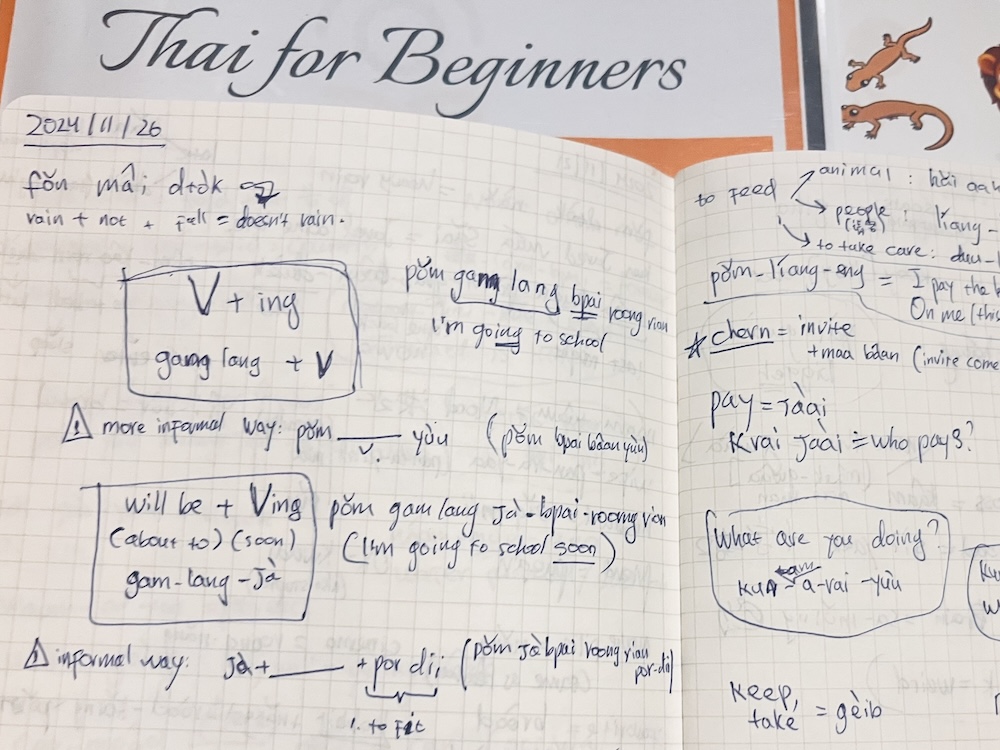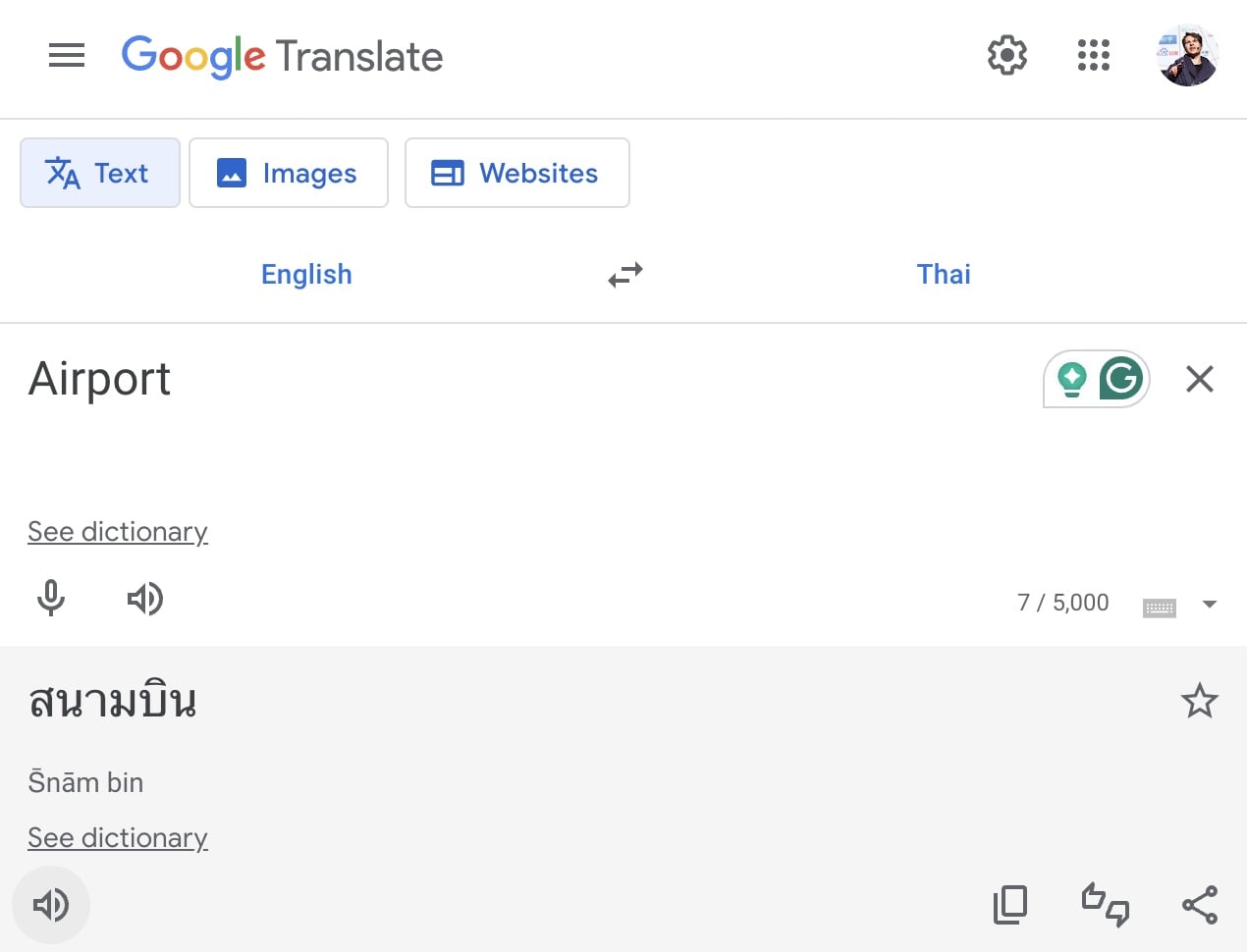My approach to learning Thai
Learning Thai has been an exciting challenge, and I’ve developed a study plan that combines regular classroom attendance, effective homework practices, and the use of modern learning tools. Here’s how I approach it:
1. Attend classes regularly
Attend your regular classes consistently and actively engage in them. Write down everything interesting your teacher says. Ask questions, and try to come up with examples to better understand the usage of vocabulary. Don’t be afraid to make mistakes. Effort matters: the more you practice, the more the language will stick in your long-term memory.

My Thai notes
Keep in mind that the romanization system used in class is not “plain English.” Forget about using English (or your native language) pronunciation rules to read this transcription. In fact, there is no single official romanization system for transliterating Thai—every school, book, and dictionary uses its own system. Accept that, rely on your own notes and hints to learn how to read the system you’re using, and work on learning the Thai script so you won’t depend on Latin letters.
Here are a couple of examples.
Our Thai teacher uses [ue] to represent the close central unrounded vowel [ɨ], which doesn’t exist in English or most Western European languages. As a native Russian, I use the letter [ы] in my notes to remind myself of this particular sound.
Another example: in our Thai school, they write all final consonants, e.g., [maak]. However, in Thai, many final sounds are not fully articulated. If you listen carefully, they’re almost silent. For example, in [mâak], the final sound is called a “k-stop.” It’s like closing your mouth after a long “aa” sound with a “k” sound, but without fully pronouncing the “k.”
2. Do your homework
Simply reviewing your classroom notes is the most basic, minimally required, and least effective thing you can do. To take your learning to the next level, you need to use effective techniques. The good news is there aren’t too many, and they’re not complicated. Here’s a quick list: retrieval practice, spaced repetition, interleaving, reflection, and effortful recall.
If you want to explore these techniques further, I recommend the book Make it Stick by Peter C. Brown. If you don’t have the time, just get Anki flashcards. Anki is a free, open-source flashcard program that uses cognitive science techniques like active recall and spaced repetition. It’s available on desktop, as a web version, and as a mobile app.

You can use Anki to create your own deck of cards. The program shows you one side of a card (front) at random, and you have to guess the other side (back). For example, it might display “toilet” on the front, and you need to recall “hôrng-náam.” After clicking “show answer,” you’ll see the back side to check if you were correct. Anki then offers four buttons: “Again” (shows the card again soon), “Hard” (shows it much later), “Good,” and “Easy.” These options help the algorithm prioritize difficult words so you see them more often than those you’ve already mastered.
How I use Anki to learn Thai
My workflow with Anki includes three types of activities: initial input, second review with card enrichment, and regular reviews.
1. Initial input
The day after class, I take my notes and log them into Anki. I created a deck specifically for my Thai school. Each card has two mandatory fields and two optional ones:
- Front side: The English word, e.g., “toilet.”
- Back side: The Thai translation using romanization, e.g., “hôrng-náam.”
- Hint (optional): A memory aid, e.g., “room + water.”
- TTS (optional): The word written in Thai, which will be read aloud using a text-to-speech engine whenever I flip the card.

In the first round, I only fill the front and back fields and add the cards to the deck. Once I’ve entered all the new vocabulary from class, I go through the cards twice to solidify them in my short-term memory.
2. Second review and card enrichment
The next day, I open Anki again. By now, there are no “new” cards—only those due for review. As I review them, I also enrich the cards:
- Add Thai script and TTS: I check Google Translate, set it to “English to Thai,” and type in the English word to get the Thai translation. I listen to the pronunciation to ensure it matches what I learned in class. Then I copy the Thai script into the TTS field.
- Add hints: For example, “airport” (สนามบิน) can be broken down into สนาม (field) and บิน (fly). If the teacher explained this in class, I write it in the hint field. Otherwise, I use Google Translate in “Thai to English” mode and experiment by removing parts of the word to see the meaning of individual components.

Enriching your cards with TTS, hints, and examples creates more “mental anchors” for remembering vocabulary.
3. Regular reviews
This is the bulk of my Anki work. When there’s nothing new to input or enrich, I focus on daily reviews. Anki shows only the cards due for review (those the algorithm predicts I might forget soon). My settings for this deck are:
- New cards/day: 30
- Maximum reviews/day: 300
- New card ignore review limit: Enabled
During reviews, I might encounter words I don’t fully understand or can’t verify through Google Translate. I mark these cards and make a note to ask the teacher about them in the next class.
Learn in a classroom. Do your homework. Use effective learning techniques. Review daily. Enjoy!
That’s it. This routine has helped me make steady progress in Thai. If you have your own tips or experiences, feel free to share them! Let’s learn together.